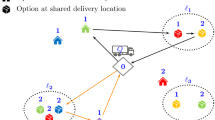Abstract
The online k-Canadian Traveller Problem (\(k\)-CTP), known to be PSPACE-complete, asks for the best strategy a traveller has to follow in order to traverse with minimum distance a graph from s to t where at most k edges are blocked. A blocked edge is revealed when the traveller visits one of its endpoints. It is proven that for any deterministic strategy, the competitive ratio is larger than \(2k+1\). Indeed, the distance traversed by the traveller is potentially greater than \(2k+1\) times the optimal journey. For randomized strategies, this ratio becomes \(k+1\). We complement the work of Zhang et al. on \(k\)-CTP with multiple travellers by evaluating the distance competitive ratio of deterministic and randomized strategies for complete and partial communication. We compare these ratios with two other communication levels: when travellers do not communicate at all and when they communicate only before beginning to move. Eventually, we provide a wide picture of the distance competitiveness reachable for the \(k\)-CTP in function of the number of travellers and communication levels.


Similar content being viewed by others
References
Bar-Noy A, Schieber B (1991) The Canadian Traveller Problem. In: Proceedings of ACM/SIAM SODA, pp 261–270
Bender M, Westphal S (2015) An optimal randomized online algorithm for the k-Canadian Traveller Problem on node-disjoint paths. J Comb Optim 30(1):87–96
Borodin A, El-Yaniv R (1998) Online computation and competitive analysis. Cambridge University Press, Cambridge
Demaine ED, Huang Y, Liao CS, Sadakane K(2014) Canadians should travel randomly. In: Proceedings of ICALP, pp 380–391
Papadimitriou C, Yannakakis M (1991) Shortest paths without a map. Theor Comput Sci 84(1):127–150
Shiri D, Sibel Salman F (2017) On the online multi-agent O–D k-Canadian Traveler Problem. J Comb Optim 34(2):453–461
Westphal S (2008) A note on the k-Canadian Traveller Problem. Inf Process Lett 106(3):87–89
Zhang H, Xu Y, Qin L (2011) The k-Canadian Travelers Problem with communication. J Comb Opt 26:251–265
Author information
Authors and Affiliations
Corresponding author
Additional information
Publisher's Note
Springer Nature remains neutral with regard to jurisdictional claims in published maps and institutional affiliations.
Rights and permissions
About this article
Cite this article
Bergé, P., Desmarchelier, J., Guo, W. et al. Multiple Canadians on the road: minimizing the distance competitive ratio. J Comb Optim 38, 1086–1100 (2019). https://doi.org/10.1007/s10878-019-00438-6
Published:
Issue Date:
DOI: https://doi.org/10.1007/s10878-019-00438-6




